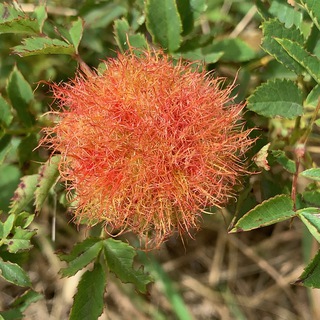I am really behind on my blog posts, but here is a random one that wasn’t actually on the backlog.
I have been using the Seek app quite a bit while wandering the fields near where I live during lockdown. This is a project to visually identify all species through an app that is based on a large open data set and models. It does an amazingly good job, only very occasionally making mistakes like identifying a diving duck briefly as a crocodile; more often it gets stuck at the genus level and finding the species a little too hard which is forgivable. Definitely recommended to make wandering around more interesting, it will link to interesting things about how species arrived, and things about them that you didn’t know from Wikipedia as well. And it is fascinating to be able to walk along paths you have been on many times before and still find a dozen new species.
The more complex a plant is, the more parasites and attackers it has. But two species, the rose and the oak, seem to have the most interesting attackers of all. I saw this mossy ball one day and was surprised when Seek told me it was a wasp, I mean it looks like a plant. So what is it?

In computer security we use biological metaphors such as “antivirus” but the complexity of the natural world really shows us what a complex attacker ecosystem looks like. This is a gall, from the gall wasp species Diplolepis rosae. It is traditionally known in the UK as Robin’s pincushion, and more formally as the rose bedeguar gall or mossy rose gall. The gall wasp female lays eggs in the leaf bud of the rose, and these eggs, and later the larvae that hatch from them, manipulate the plant into growing the gall around it. This is why it looks like a plant like structure, as indeed it is, but not a normal one. In particular, the gall provides highly nutritious plant cells for the wasp larvae to eat, with the plant transporting nutrients directly to the gall for it to eat. It grows in weird ways, but using the host plants genetic material, manipulated by the wasp in ways that are not yet understood.
This is exactly the mechanism of weird machines in computer security, where “the implicit data flow and the subsequent transfer of control were performed by the program’s own code, borrowed by the exploit for its own purposes.” The attacker takes gadgets and existing code fragments and applies them in unexpected, unplanned for, weird ways to make the code do things that were not intended by the author, indeed things that are totally outside the designed scope. “Borrowed pieces of code could be strung together, the hijacked control flow linking them powered by their own effects with the right crafted data arranged for each piece.”
Gall wasps are widespread, and each species produces a different type of gall, by attacking the plant in a different way. But roses and oaks seem to be the main hosts. Around where I live these particular rose species are very common, found on a lot of the wild roses. There are also several kinds of oak gall wasp around.
It turns out that the galls themselves allow complex attacker communities to thrive. Other species of wasp live in the comfortable gall habitat. In general the other species are not parasitic on the gall wasps, as only these have the ability to keep attacking the host rose to keep the flow of nutrients coming. But other wasp species lay eggs in the same place a little later to also live in the same habitat, and indeed can only live in these places, a lifecycle known as “inquiline”. There are parasites on the inquilines, and a complex community of attackers; the majority of the wasps that hatch out the next year will not be the original species that caused the gall. The gall is itself easier to attack than the plant, because of how it has been manipulated into a softer mass.
Another random fact about the Diplolepis rosae wasp is that almost all of them are female. This is actually in itself due to a bacterial infection of the gametes, with the bacteria manipulating the wasp so it only produces female eggs.
One of the interesting things about computer security is that we are only just starting to see the structure of attacks and defence. The natural world has so many different attack and defence mechanisms that are worth exploring to see what happens when things are subverted in novel ways, or have different types of defence, or little defence at all. Or you can just wander around and learn about the amazing natural world.